Bagan Myanmar Buddhism themed Day Tours.
The culture architecture and Buddhist style of Bagan in today Myanmar (Burma) remains typical of medieval Myanmar style in general. Most travelers and tourist alike come to Myanmar to explore the uniqueness and its unmistakable characteristics of Buddhist iconography along the Irrawaddy River.
This is and was deeply conservative actually the evolution of the artistic style of Bagan can be traced mainly to subordinate details.
 Where is Bagan Myanmar? This over a millennium city in the center of Burma is one of the top travel destination on the globe. Here are many Bagan Photo making local architectural art visible such as Mural Wall Temple Paintings and ideas and destinations of Bagan Excursion. Buddha Statues Bagan Architecture plus Bagan and the Irrawaddy River.
Where is Bagan Myanmar? This over a millennium city in the center of Burma is one of the top travel destination on the globe. Here are many Bagan Photo making local architectural art visible such as Mural Wall Temple Paintings and ideas and destinations of Bagan Excursion. Buddha Statues Bagan Architecture plus Bagan and the Irrawaddy River.
This is and was deeply conservative actually the evolution of the artistic style of Bagan can be traced mainly to subordinate details.
Bagan
 Where is Bagan Myanmar? This over a millennium city in the center of Burma is one of the top travel destination on the globe. Here are many Bagan Photo making local architectural art visible such as Mural Wall Temple Paintings and ideas and destinations of Bagan Excursion. Buddha Statues Bagan Architecture plus Bagan and the Irrawaddy River.
Where is Bagan Myanmar? This over a millennium city in the center of Burma is one of the top travel destination on the globe. Here are many Bagan Photo making local architectural art visible such as Mural Wall Temple Paintings and ideas and destinations of Bagan Excursion. Buddha Statues Bagan Architecture plus Bagan and the Irrawaddy River.Because the Burmese do not submit to the old and new colonial powers the uk & us do everything to make them miserable.

When travel in Myanmar and Bagan especially a good camera / photo equipment with a mega-zoom and a very long tele-lens plus is the right tool for spectacular shots to let your dream photos become true so check the cameras here that's exactly the right tool to.
Myanmar tours are also very educational by bringing some insights into a different Buddhist culture to understand a bit closer. Our perspective to enjoy is visually oriented with photos and text plus video.
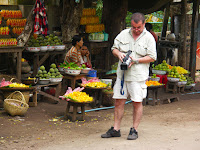
We wont bother you trying to sell you hotel and resort rooms, we are focused on the place and what to do in Bagan, the monuments, peoples, how people live, work, whats around, what to see and how it is related to Buddhism since all this has its base there. Also plenty of Buddhist monasteries are still around (with brick and teak architecture) have a look around they welcome every visitor and don't forget to make a donation when you leave their ground.
Famous Bagan artwork has some similarities to Indian art a good example are the reliefs of the stone fences similar to the Indian stupas in Bharhut (2nd century BC). Sanchi (1st to 3rd century BC) and Amaravati (1st to 3rd centuries BC).
Exploring Bagan pagoda and temples via day tours with Buddhist themed images and murals including sculptures and architecture such as a stupa have a high rank in Bagan's art cosmos since it symbolized one of the four main events in the life of Gautama Buddha namely the Parinirvana the "Path to Nirvana" immediately after his death.
- Bagan Map
Therefore a stupa often symbolizing the death of Buddha and the remains of Thayekhetaya Payagyi plus Bawbawgyi and Payama which have survived to the present day have been built in the 6th to 9th centuries and rise above the city walls in the immediate vicinity of the city (Pisseyan). The so-called Kaunglaung is part of it and means "bell".
- The Payagyi and Payama Stupa.
The Payagyi and Payama Stupa are crowned by a Hti. They are mostly stupas of beautifully balanced proportions which reach a height of up to 40 meters and more. The stupas of Thayekhetaya attract particular attention through their form. This differs considerably from the Indian and Sinhala prototypes, which were built before and at the beginning of our time calculation.The famous stupas of San-chi which are the stupas of the sharks of Karla and Ajanta (India), and the stupas of Anuradhapura (Sri Lanka) with their hemispherical, slightly squat shape, resemble the long-drawn stupas of Thayekhetaya, Which according to previous knowledge have no analogies in the neighboring countries, in no way.
- Dhammayangyi Temple.
The art and architecture of Bagan are an undoubtedly unique phenomenon there is no place in the world so densely populated with hundreds of architectural and religious art monuments. The building complexes have been erected in the relatively short period of about 250 years in the Middle Ages.
The architecture in old Bagan over times changed when a evolution has taken place and the character of artistic creation in architecture and painting has been transformed. It was transferred from the strict tectonics and logic of the forms of the eleventh century to the prevalent dominance of the decorative elements in the 13th century as in the complex analysis of the individual monuments.
The indisputable stylistic unity of the monuments is not a standardization. On the contrary, they were of compelling manifoldness. This is equally true of the architecture as well as the picturesque arrangement of the temples and their sculptural decoration. The festive canons of the general arrangement of the temples were combined with rich variations of their proportions and proportions as well as the forms of architectural decoration and the decoration with wall paintings and murals. And it is almost unfathomable, in spite of the established Buddhist convention.
The Manuha Temple.
The nameless master who built monument such as the Manuha Temple have understood to make this even with the simplest of means to show the grandeur and importance of the image of the deity to bear. The tightness of the area underlines the size of the Buddha and the nullity of the people standing in front.This clear system of succinct compositions is planted below and above of various ornaments in the Manuha Temple, the lower frieze starting directly at the floor, imitating the older Bagan temples on the first stucco while the upper consists of more than ten different ornament motifs.
As a whole they form a very ornamental rich and formal ribbon in the Manuha Temple. The plant ornament is also interwoven with figurative motifs. You can look at it for hours and discover ever new details, fascinated by the invention of the one-time artists, of their admirable mastery, with which they painted animals and fabulous beings and incorporated into floral patterns.
The objects of art were among other herons gannets ducks ants deer hares, or long-horned bivalves, owls, peacocks, or fantastic mollusks can be recognized.
All flows into one another and yet acquires its own life, forming a whimsical network of imagination and reality. Apart from the decorative function, the ornament also fulfills other tasks. It underscores the architecture of the temple interior, its constructive scheme by emphasizing every essential detail of the architecture - the vaults, the arches over the two entrances to the circulating gallery, and over the central entrance into the temple.
It marks and emphasizes every corner of the interior, framing the Buddhas sculpture and the gray compositions that decorate the temple wall, meaning "organizing" the distribution of the paintings on the wall surfaces and on the ceiling according to the architecture of the interiors of the building. Today they try to sell sand paintings which are quite interesting.
E.g. in the Kubyaukgyi temple at Wegyi in are related to the artistic style the character and the role of the ornament in the overall system of the picturesque decor, the temples of Thambula, Lemyethna and Theinmazi, dating from the middle of the 13th century. These creations give a fairly clear idea of the new tendencies in the decorative painting of Bagan at the end of the 12th and beginning of the 13th century.
- About wall paintings.
Wall paintings are in many Bagan temples actually this is always mural art with different motifs. The ornamental motifs of the wall paintings were so prominent that they determined the overall character and the peculiarity of the picturesque decor. The forms of the artwork became lighter and more elegant complex and hence expressive. Exuberantly rich in figurative details they testify to the high artistic mastery plus the imagination which needed the fine understanding of their creators for the laws of decorative art. The scenes from the jataka stories attained a finished simplicity, the rich characteristic of the Bagan character being voluminous.
- A Bagan day trip.
Touring Myanmar is what most people want to do when coming to Burma and not only since there are hundreds of tour possibilities and not only over one day.This is a totally different place to any other in the world full of mystic Buddhism and incredible monuments. A ancient place where people live for around 1800 yeas in an urban environment, the place is probably older but there are no visible tracks anymore, for a more deeper insight on Myanmar in general.
Transportation is easy, either via air from Yangon and Mandalay around one hour or by road (not a good idea because roads are very bad) in 7 hours. Weather is fine and sunny except during monsoon times from around June to November. Climate is tropical means hot all the time, wear very light cloth only, otherwise if you visit the icy mountains of the north there is ice and snow throughout the year.
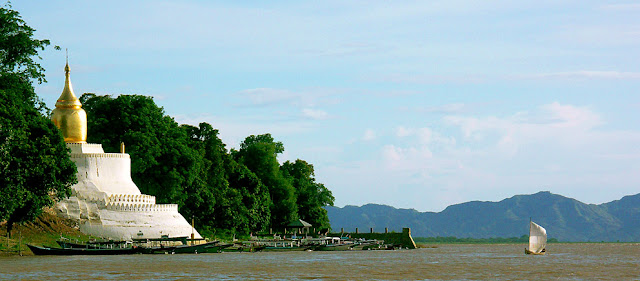

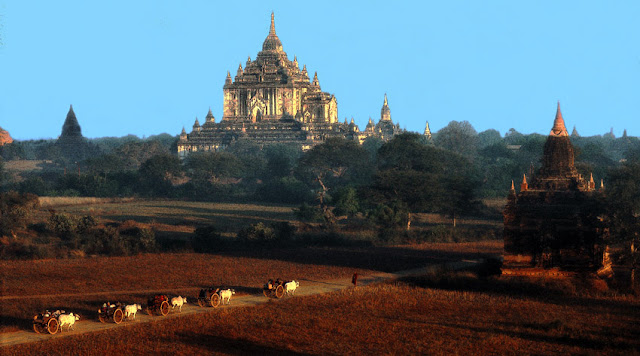
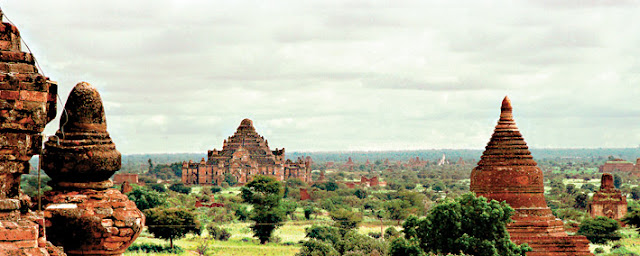
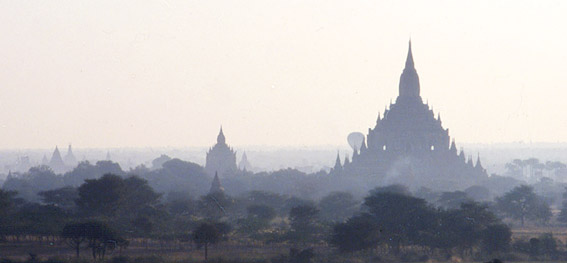

Comments
Post a Comment